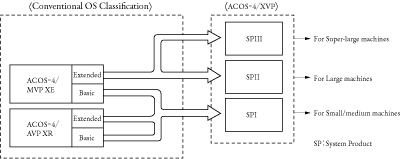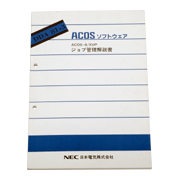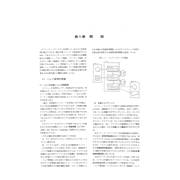NEC started shipping ACOS-4/XVP (eXtended multi Virtual Processor) in April 1991.
ACOS-4/XVP was an operating system (OS) that expansively integrated the previous models ACOS-4/AVP XR and ACOS-4/MVP XE and covered all ACOS systems (3400, 3500, 3600 and 3800), ranging from small/medium machines to super-large machines.
Features of the newly adopted architecture and of major functions were as follows:
1. Features of the Architecture
(1) Expansion of the virtual storage space to up to 128 TB
The maximum virtual memory size of the first
ACOS-4 was 240 MB per process; that of
ACOS-4/MVP XE, shipped in 1985, was expanded to up to 2 GB. ACOS-4/XVP provided an extended data space of up to 128 TB through 47-bit addressing other than the conventional 2-GB basic address, and also released the memory to the user. The data space was a process-specific space, as with the basic address space, and each process could have an independent 128-TB extended data space.
 Figure 1 Expansion of the logical space
Figure 1 Expansion of the logical space(2) Extended storage EMU (Extended Memory Unit)
EMU was a fast, large-capacity storage capable of transferring data to and from the main memory at high speed, and it increased the performance of overall system processing by being used as a buffer pool for a database or as a paging/swapping area.
(3) Basic part of the OS with scalability
ACOS-4/XVP covered all ACOS systems, from small/medium to super-large systems, with a single OS. The basic part of the OS consisted of three levels (SP I, SP II and SP III) according to the size of the system in order to optimize the specifications (e.g., memory size, number of processes) of the basic part.
 Figure 2 Basic part of the OS (SP I, SP II and SP III)
Figure 2 Basic part of the OS (SP I, SP II and SP III)2. Features of the Functions
(1) Support of larger and open networks
The OS adopted a 31-bit network address, enabling up to 2.1 billion computers/workstations to be connected. In addition, it supported international standard protocol OSI and industrial standard protocols as well as open-server connection based on the TCP/IP socket interface to improve connectivity with multi-vendor/multi-platform environments.
(2) Increased size and performance of relational database and support of SQL
The OS provided the relational database system RIQSII V2, which supported increased size and performance in order to reliably store large amounts of data and use them quickly and effectively. RIQSII V2 complied with international standards, including SQL, to enable clients to use ISV software on PCs that supported the SQL interface.
(3) Improved operability through automation and laborsaving operation
The OS supported increasingly complex system operation through achieving centralized monitoring of the operational status of multiple systems at one point, automatic response to important messages issued from the system and automation of system operation control with an operation calendar/schedule, by using functions for automation/laborsaving operation, including TOM (Total Operation Management).
(4) Increased reliability through mutual backup between multiple host computers
With the conventional hot standby configuration, the load was concentrated on one host computer after changeover and the response and throughput were substantially decreased because the configuration consisted of one active host computer and one standby host computer. This OS enabled multiple host computers to back up each other, achieving load distribution after changeover, increased reliability and increased machine utilization.






